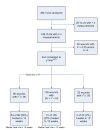Nonlinear modeling of venous leg ulcer healing rates
- PMID: 19335882
- PMCID: PMC2672927
- DOI: 10.1186/1471-5945-9-2
Nonlinear modeling of venous leg ulcer healing rates
Abstract
Background: The purpose of this manuscript was to determine whether the change in wound surface area over time could be described through nonlinear mathematics.
Methods: We studied 3,588 serial wound tracings of 338 venous leg ulcers (VLUs) that had been followed during a controlled, prospective, randomized trial of two topical wound treatments.
Results: A majority (72%) of VLUs exhibited surface area reduction via an exponential decay model, particularly during the early stages of healing. These results were consistent with the mechanics of wound contraction and epithelial cell proliferation, supported by the higher frequency at which exponential surface area reduction associated with full wound closure (35% of wounds that fit the exponential model healed vs. 21% of wounds that did not fit the exponential model completely healed during the study period, p = 0.018). Goodness-of-fit statistics suggested that much of the individual variation in healing could be described as nonlinear variation from the exponential model.
Conclusion: We believe that parameter estimates from a mathematical model may provide a more accurate quantification of wound healing rates, and that similar models may someday reach routine use in comparing the efficacy of various treatments in routine practice and in product registration trials.
Figures




References
Publication types
MeSH terms
Substances
LinkOut - more resources
Full Text Sources

